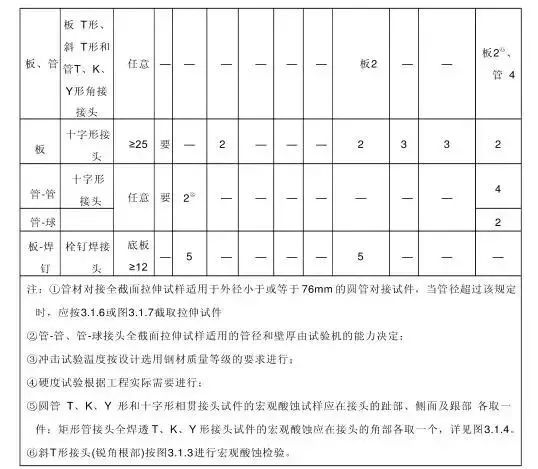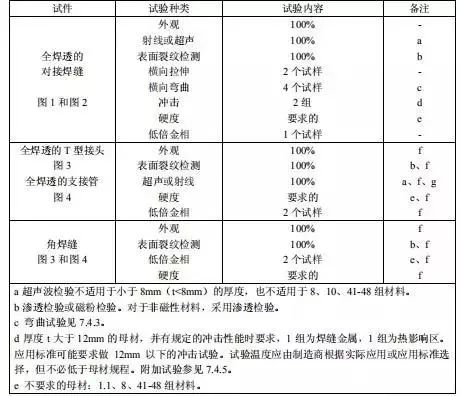1. The main specifications for the process evaluation basis of the construction steel structure industry
★ GB 50661
★ AWS D1.1
★ Eurocode
Welding procedure test (EN ISO 15614): Method of welding and testing a standard test panel to determine the welding procedure.
Test welding consumables (EN ISO 15610): Method for determining welding procedures by testing welding consumables.
Previous Welding Experience (EN SIO 15611): Method for obtaining a welding process through demonstration of previous satisfactory welding capabilities.
Standard welding procedure (EN ISO 15612): Method for obtaining welding procedures using standard welding procedure specifications.
Pre-production welding test (EN ISO 15613:) Method for determining the welding procedure by pre-production welding test.
Destructive testing of welds in metallic materials EN ISO 9018: Tensile testing of cross and lap joints
★ JIS JASS6
2. The main contents and characteristics of each system specification process evaluation
2.1 The content and characteristics of GB50661 process evaluation specification
(1) The regulations clarify the scope of welding procedure qualification that must be carried out, and replace the rules for welding procedure qualification;
(2) The welding process test piece should be welded by skilled welding personnel in the construction enterprise;
(3 The base metal is divided into four categories according to the strength level;
(4) Specimen joint form and test sample preparation;
(5) Exemption from the provisions of the assessment clause:
①Welding methods and welding positions exempted from qualification
②Exempted base metal/filler metal combination
③Minimum preheating temperature and interpass temperature
④Weld size
⑤ Welding process parameters
⑥ Welding joint structure
(6) According to the provisions of this specification, welding test pieces, cutting samples, and testing units with the certification qualification of the national technical and quality supervision department shall conduct testing and testing.
Features
(7) Welding procedure qualification must be assessed separately for different welding methods and welding positions;
(8) Longitudinal bending specimens are not mentioned in the bending test regulations, and cracks appearing at the corners are not treated differently in the qualification standard;
(9) There is no provision for macroscopic metallographic test for the butt test plate.
2.2 The content and characteristics of the EN standard process evaluation specification
(1) The base metal grouping (EN 15608) is not grouped by a certain material specification system, but is grouped by chemical composition, strength and supply status, so that steels from different countries can be well included in this grouping In the system, the coverage of material groups has been expanded.
(2) The methods of process evaluation include: EN ISO 15614, EN ISO 15610, EN ISO 15611, EN ISO 15612, EN ISO 15613 Users can choose the appropriate method according to their own situation to meet the specification requirements
(3) The specification (EN ISO 15614-1) applicable to the welding procedure test evaluation method for arc welding of steel structures has the following characteristics:
① Process qualification and welder qualification;
② Inspection and witness of process qualification test;
③Standard test board
④ Coverage of welding position
⑤ Items of process test: visual inspection, RT or UT, surface crack inspection (PT or MT), tensile, bending, hardness, impact and macroscopic metallographic test;
⑥ Requirements for bending test
⑦ Sampling position and qualification criteria of impact sample
2.3 AWSD1.1 standard process evaluation specification content and characteristics
(1) Restrictions on WPS exemption from assessment:
① Welding method
② Base metal/filler metal combination
③ Minimum preheat temperature and interpass temperature
④ Limitations of WPS Variants
⑤ Limitations of joint size and tolerance
⑥ Fillet weld
⑦ Post-weld heat treatment
(2) Requirements for WPS exempted from assessment:
① General requirements
② Special requirements
(2) The specification does not require qualifications for welders who perform welding procedure qualification operations;
(3) The base metal is graded according to ASTM, ABS and API specifications;
(4) The welding procedures that can be exempted from qualification are specified and detailed provisions are made, and the base metals of exempted qualification procedures are limited to those listed in the specification;
(5) Welding procedure qualification must be assessed separately for different welding methods. Among them, GMAW also stipulates the form of droplet transfer. It is clear that GMAW-S of short-circuit transfer is an independent welding method and needs to be evaluated separately, which is consistent with the EN specification;
(6) The coverage of the welding position is also clearly defined in the specification, which is stricter than the EN specification;
(7) Specimen joint form and test sample preparation;
3. What are the components of qualification in welding process?
Chapter 4 of AWSD1.1:2015 includes two welding procedures, “exemption” and “qualification” procedures; this chapter also includes the relevant qualifications required for welders, welding operators and spot welders. According to AWS D1.1:2015 Chapter 3 on “Exemption Procedures”, in the exemption link, there is no need to test the welding procedures of specific projects. However, AWS D1.1:2015 Section 4.19 states that the deviations covered in this section must be tested by welding procedures. Testing the welding procedure is time-consuming and costly. If the welded joints of the previous project have been tested, when similar welded joints appear in the new project, the newly-emerged joints need to be re-tested. Likewise, contract documents sometimes specify that haphazardly implementing waiver procedures for welding technicians may arbitrarily increase the cost of the overall welding construction process. AWS D1.1:2015 Section 4.19 states: Numerous written records demonstrate that qualification-exempt joint welding procedures are acceptable without repeated qualification. In addition, written evidence of exemption from qualification for welders, welding operators, and spot welders is acceptable without repeated qualification, provided that such written documents are specified in AWS D1.1:2015 Section 4.24. within the specified validity period
4. Requirements of each system specification for process qualification test
4.1 GB50661 Requirements for Process Evaluation Test Items


4.2 Requirements of EN standards for process qualification test items






4.3 AWS Standard Requirements for Process Evaluation Test Items

4.4 Comparison of different specifications for process requirement tests
Test project comparison

Bend test comparison

Impact test comparison

4.5 Welding procedure qualification coverage
The thickness of the test piece qualified for GB assessment and the thickness applicable to the project

(1) For pipes with an outer diameter less than 600mm, the diameter coverage should not be less than the outer diameter of the process evaluation test pipes;
For pipes with an outer diameter of ≥600mm, the diameter coverage is greater than or equal to 600mm.
(2) The welding procedure qualifications for the butt joints of plates and pipes with an outer diameter of not less than 600mm can be substituted for each other.
(3) The evaluation result of the horizontal welding position can replace the flat welding position, but not vice versa (except for stud welding). Vertical and vertical welding positions and
Other welding positions are not interchangeable.
(4) One-sided welding full penetration joints with backing plate and no backing plate are not interchangeable;
Interchangeable; pads of different materials are not interchangeable.
ISO EN assessment covers qualified specimen thickness and engineering applicable thickness



AWS assessment covers qualified specimen thickness and engineering applicable thickness



4.6 Changes in welding procedure qualification parameters and comparison of re-assessment requirements



5. Limitation period for welding procedure qualification
As an important guiding document for welding work, the importance of welding procedure qualification is self-evident. Regardless of any project and implementation of any standard, the welding procedure qualification must be submitted to the owner or the supervising engineer for review and approval before the start of the project welding work. Since the welding procedure evaluation involves test plate welding, mechanical (chemical) performance test, report issuance, supervision witness and other links, the cost is relatively high. As a well-established enterprise, there will be a database of welding procedure qualifications. Before the start of a new project, the appropriate procedure qualifications will be selected from the database according to the project’s plate thickness, base metal, welding consumables and other factors to reduce costs and save money. time. Often engineers do not pay attention to the validity period of the process evaluation, which causes the submitted evaluation to expire and delays the submission of materials.
This paper introduces the validity period of welding procedure qualification of different standards.
1. American Standard – AWS D 1.1
The American Standard stipulates that the earlier version of the process qualification is valid and has no time limit.
2. European Standard – EN 1090-2
1.1 Intermission period 1-3 years
Material grades higher than S355 require corresponding workpiece tests to verify. Tests and inspections shall include appearance, radiographic or ultrasonic, magnetic particle or infiltration, macroscopic metallography and hardness.
1.2 Intermittent for more than 3 years
a) For steels of S355 and below, select the macroscopic metallography for testing.
b) For steel above S355, re-evaluate.
3. National Standard – GB 50661
Except for the joints that can be exempted from the assessment, the validity period is 5 years for steel structure projects of welding difficulty grades A, B and C. For steel structure projects with welding difficulty level D, the welding procedure evaluation shall be carried out according to the project.
Post time: Jun-06-2022
